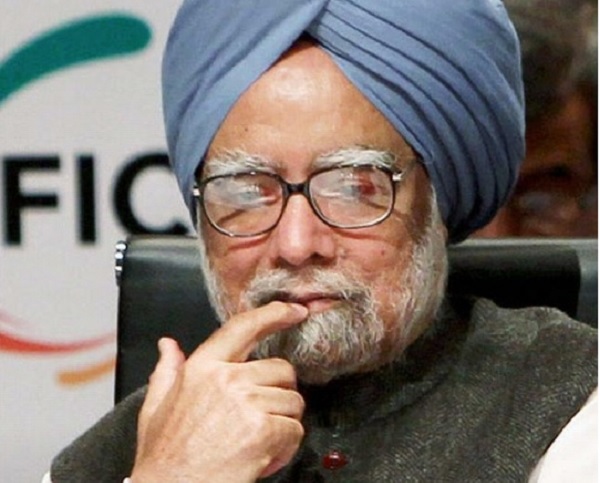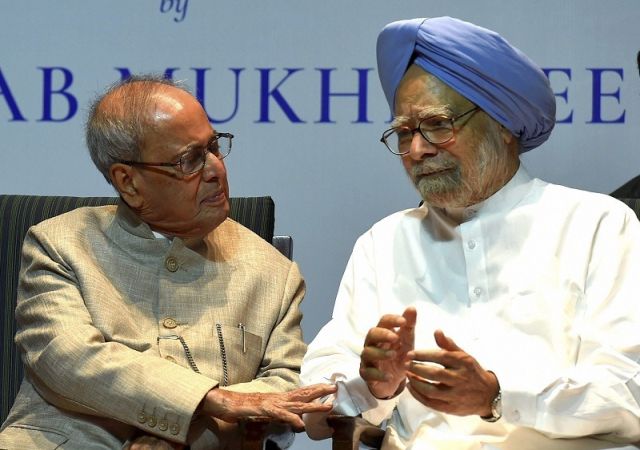
by admin | May 25, 2021 | News, Politics
 New Delhi : Congress President Rahul Gandhi on Wednesday constituted a 46-member Drafting Committee headed by former Prime Minister Manmohan Singh for the party’s March 16-18 plenary here.
New Delhi : Congress President Rahul Gandhi on Wednesday constituted a 46-member Drafting Committee headed by former Prime Minister Manmohan Singh for the party’s March 16-18 plenary here.
He also constituted an Organising Committee, four subgroups, besides a Constitution Amendment Committee.
The Organising Committee headed by party Treasurer Motilal Vora has Oscar Fernandes as Convenor and party General Secretaries and incharges of states as members.
There are nine special invitees to the Organising Committee, including Ahmed Patel, Sheila Dikshit, Ajay Maken and Kuldeep Bishnoi.
Party leader Mukul Wasnik is Convenor of the Drafting Committee that will finalise resolutions to be adopted at the session.
The Drafting Committee has party heavyweights like former Union Ministers A.K. Antony, P. Chidambaram, Ghulam Nabi Azad and Mallikarjun Kharge, besides Punjab Chief Minister Amarinder Singh.
The ‘political’ subgroup headed by Antony has former Union Minister Kumari Selja as Convenor. Members include Azad, Kharge and former Rajasthan Chief Minister Ashok Gehlot.
The ‘economic affairs’ subgroup headed by former Finance Minister P. Chidambaram has Jairam Ramesh as Convenor and Antony, Kamal Nath, Anand Sharma and M. Veerapa Moily among the members.
The ‘international affairs’ subgroup headed by Anand Sharma has party MP Jyotiraditya Scindia as Convenor and its members include former Lok Sabha Speaker Meira Kumar, Antony, Chidambaram, Salman Khursid, Shashi Tharoor and Amarinder Singh.
The subgroup on ‘agriculture, employment and poverty alleviation’ headed by former Haryana Chief Minister Bhupinder Singh Hooda has former MP Meenakshi Natarajan as Convenor and members include Amarinder Singh, K.V. Thomas, Randeep Surjewala, and Jairam Ramesh.
The Constitution Amendment Committee headed by Azad has Janardan Dwivedi as Convenor.
—IANS

by admin | May 25, 2021 | Economy, Markets, News, Politics

Manmohan Singh
Surat : Former Prime Minister Manmohan Singh on Saturday said it was too early to conclude that the economic slowdown has reversed as the 6.3 per cent growth rate in the July-September quarter did not take into account the small and medium sector which suffered huge losses in the aftermath of demonetisation and hasty implementation of GST.
He welcomed the 6.3 per cent growth rate in the July-September quarter but cautioned that it was too early to conclude that the economy has recovered.
“(It) is too early to conclude that this represents a reversal of the declining trend observed in the previous five quarters. Some economists believe that the CSO which released the figures has not adequately captured the impact of demonetisation and GST on the informal sector that accounts for about 30 per cent of the economy,” Singh said addressing professionals and businessmen here in the election-bound state.
He quoted renowned economist Govinda Rao identifying a “problem” with the calculation of manufacturing growth based on corporate results.
“This doesn’t take into account the small and medium sector which suffered the most after demonetisation and the launch of GST. A couple of big worries remain. Farm sector growth fell to 1.7 per cent from 2.3 per cent in the previous quarter and 4.1 per cent in the same quarter last year,” Singh said, citing Rao.
He said that after farming, job losses have been the most in the construction sector.
Singh criticised the BJP government’s economic policies, particularly the “coercive steps” of note ban and the Goods and Services Tax (GST) that cost the nation hugely and “broke the back of businesses”.
“We saw the impact of demonetisation on the economy when the GDP growth dropped to 5.7 per cent in the first quarter of 2017-18 under the new calculations. Even this is bound to be a gross underestimate as the pain of the informal sector is not adequately captured in the GDP calculation.
“Every one per cent loss of our GDP growth rate annually costs our nation Rs 1.5 lakh crore. Think of the human impact from the lost growth — the lost jobs, the youth whose opportunities have vanished, the businesses who had to shut down and the entrepreneurs whose drive to succeed has turned into discouraged disappointment.”
Singh said that the decline in farming and construction sectors was despite the fact that the government had front loaded its spending on projects, “forcing up our fiscal deficit to a high of 96.1 per cent of the Rs 546,432 crore target set for the full year”.
“This means that private spending on construction has been very dismal… Thus there is still considerable uncertainty about the growth of GDP. The RBI forecasts that growth in 2017-19 will pick up to 6.7 per cent. However, even if growth reaches 6.7 per cent in 2017-18, Modiji’s four year average growth rate will be only 7.1 per cent.
“To equal the UPA’s 10 year average, the economy will have to grow at 10.6 per cent in the fifth year. I would be happy if this were to happen, but frankly I do not think it will.”
The former Prime Minister said while Modi claimed to understand Gujarat and the poor “more than anybody else”, how was it that “he never understood the pain his decisions unleashed”.
He hailed the people of Surat city, renowned world over for the diamond and the textile industries, and said it was one of the worst sufferers of note ban and GST.
“It is no wonder that Surat voiced the biggest protests in India against this injustice by the NDA government. You after all come from the land of two great souls — Mahatma Gandhi and Sardar Patel. When the Mahatma decided to protest against the unjust British tax on salt, he did it from your backyard in Dandi. Standing up for injustice is in your blood and you raised your voice against the shoddy implementation of GST,” he said.
—IANS

by admin | May 25, 2021 | News, Politics
 New Delhi : Former President Pranab Mukherjee expected to be chosen as Prime Minister on two occasions — first in 2004 when the United Progressive Alliance (UPA) came to power, and later in 2012 ahead of the Presidential election, he writes in his latest book “Coalition Years: 1996-2012”.
New Delhi : Former President Pranab Mukherjee expected to be chosen as Prime Minister on two occasions — first in 2004 when the United Progressive Alliance (UPA) came to power, and later in 2012 ahead of the Presidential election, he writes in his latest book “Coalition Years: 1996-2012”.
Mukherjee, a veteran Congress leader, also says that after Sonia Gandhi named Manmohan Singh as her choice for Prime Minister, he was actually reluctant to join the government as a cabinet minister under Singh, who had been his junior when he was Finance Minister under Indira Gandhi.
However, he rubbishes the perception that Manmohan Singh was an “accidental Prime Minister”.
“A strong nationalist, a man of courage and conviction, Manmohan Singh was certainly not an ‘accidental Prime Minister’. I am convinced that the future will judge Manmohan Singh in a different light as (former Prime Minister) P.V. (Narasimha Rao) is assessed today,” Mukherjee says.
After Sonia Gandhi declined the UPA leaders’ proposal to become Prime Minister on May 18, 2004, “there was intense speculation in the party and the media about her choice”, Mukherjee writes.
“Within the Congress party, the consensus was that the incumbent must be a political leader with experience in party affairs and administration… The prevalent expectation was that I would be the next choice for Prime Minister after Sonia Gandhi declined,” the Congress stalwart writes.
He says that this expectation was possibly based of the fact that “I had extensive experience in government while Singh’s vast experience was as a civil servant with five years as a reformist Finance Minister”.
Finally, Sonia Gandhi named Manmohan Singh as her choice and he accepted this.
“Some media commentators reported that I would not join the government because I could not work under Manmohan Singh, who had been my junior when I was the Finance Minister. The fact was that I was reluctant to join the government, and informed Sonia Gandhi accordingly,” Mukherjee says.
Speaking at the release of the book recently, Manmohan Singh said Mukherjee had every reason to feel that he was better qualified than him for the Prime Minister’s post.
He also said that contrary to what people may say or write, the two had no serious differences or friction on any matter during the UPA era.
Mukherjee elaborates that once he joined the government at Sonia Gandhi’s insistence, he enjoyed good rapport with Manmohan Singh who “seemed to depend” on him.
“She (Sonia Gandhi) insisted that I should join the government since I would be vital to its functioning and also be of support to Dr. Singh. As it turned out, Dr. Singh would talk to me on all important issues and seemed to depend on me. We shared a good working relationship,” Mukherjee says.
The second occasion when Mukherjee expected he would be asked to head the government came just ahead of his nomination as the presidential candidate.
After a meeting with Sonia Gandhi on June 2, 2012, when the Congress President discussed with him probable presidential candidates — including him — Mukherjee “returned with a vague impression that she (Sonia Gandhi) might wish to consider Manmohan Singh as the UPA presidential nominee”.
“I thought that if she selected Singh for the presidential office, she may choose me as the Prime Minister. I had heard that she had given this formulation a serious thought while on a holiday in the hills,” he writes.
—IANS

 New Delhi : Congress President Rahul Gandhi on Wednesday constituted a 46-member Drafting Committee headed by former Prime Minister Manmohan Singh for the party’s March 16-18 plenary here.
New Delhi : Congress President Rahul Gandhi on Wednesday constituted a 46-member Drafting Committee headed by former Prime Minister Manmohan Singh for the party’s March 16-18 plenary here.
